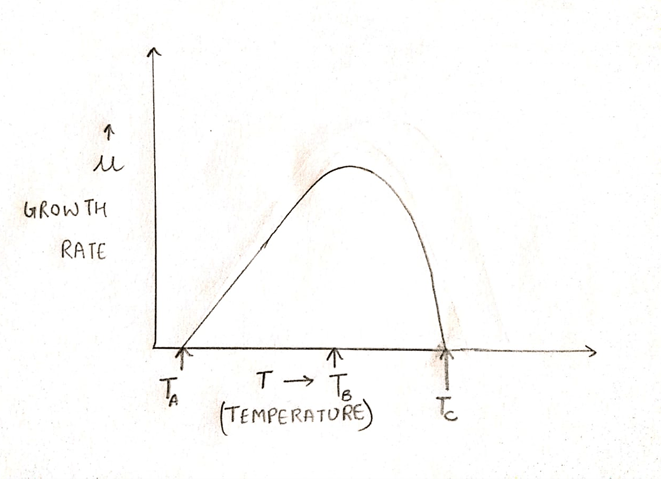This set of Food Microbiology Multiple Choice Questions & Answers (MCQs) focuses on “Microorganisms Growth Factors”.
1. The minimum, optimum and maximum temperatures an organism can grow at are called ______ temperatures.
a) Cardinal
b) Major
c) Key
d) Critical
View Answer
Explanation: In the graph of growth rate vs temperature, they are three cardinal temperatures represented by 3 points viz. minimum temperature, optimum temperature and maximum temperature. These tell us about the characteristics of a particular organism and are different for different microbes. The classification of microbes can be based on their cardinal temperatures.
2. _______ can be frequently found in humans and animals because of their optimum temperature.
a) Psychrophiles
b) Mesophiles
c) Thermophiles
d) Psychrotrophs
View Answer
Explanation: Mesophiles have an optimum temperature of around 37°C, which is the average body temperature of humans and animals. Mesophiles thrive quickly and hence contribute to faster spoiling of food. Some mesophiles are Salmonella and Clostridium perfringens.
3. Some microbes can adapt to lower temperatures by increasing the amount of unsaturated fatty acids in the membrane.
a) True
b) False
View Answer
Explanation: When the degree of unsaturation increases, it will lead to the dipping of the melting point. Hence, the membranes will remain fluid and the microbe will be able to survive in spite of the low temperature. This can be achieved by reducing the length of the fatty acids too.
4. The reaction rate doubles with every ___ rise in temperature.
a) 1°C
b) 10°C
c) 10 Kelvin
d) 1 Kelvin
View Answer
Explanation: Reactions follow the Arrhenius law, according to which
k = A*e-(Activation energy/RT), where k is the rate constant, A is the Arrhenius constant, T is the temperature and R is the Gas constant. Linearizing the following equation, we get,
ln(k2/k1) = (Activation energy/R) * ((1/T1) – (1/T2))
Hence, a 10°C rise in temperature doubles the rate of reaction in most chemical and biological processes.
5. Bacteria that are able to survive Pasteurization temperature are called _____
a) Halotolerant bacteria
b) Thermophilic bacteria
c) Thermoduric bacteria
d) Osmophilic bacteria
View Answer
Explanation: The bacteria that are able to withstand Pasteurization temperature of 72°C are called thermoduric bacteria. Halotolerant bacteria can survive high salt concentration whereas thermophilic bacteria grow and thrive at temperatures above 50°C. Osmophilic bacteria can grow at a relatively higher osmotic environment than other bacteria.
6. At lower temperatures, what adaptation do microbes exhibit to maintain membrane fluidity?
a) Osmoregulation
b) Heteroviscous
c) Homeoviscous
d) Salt regulation
View Answer
Explanation: Homeoviscous adaptation refers to the changes made in the lipid membrane so as to maintain the desire cell membrane fluidity. At lower temperatures, this includes increase in the concentration of unsaturated lipids whereas at higher temperatures, it includes an increase in saturated lipids.
7. What is the optimum temperature range for thermophiles?
a) 40-45°C
b) 20-30°C
c) 60-90°C
d) 55-75°C
View Answer
Explanation: The optimum temperature range for thermophiles is 55-75°C. The minimum temperature range is 40-45°C whereas the maximum temperature range is 60-90°C.
8. The heat resistance of a microbe is directly proportional to the incubation temperature.
a) True
b) False
View Answer
Explanation: Genetic selection and the mechanisms to keep the microbe alive activate the heat-resistant genes to function more when the temperature is increased. For example, S senftenberg was 3 times more heat resistant at 44°C than at 35°C.
9. Psychrotrophs are also called __________ psychrophiles.
a) Obligate
b) Ordinary
c) Facultative
d) Complex
View Answer
Explanation: Psychrotrophs or facultative psychrophiles have a minimum temperature range same as obligate psychrophiles ie -5 to +5°C. However, their maximum range is higher than that of obligate psychrophiles. The maximum range for psychrotrophs is 30-35°C whereas, for psychrophiles, it is 15-20°C.
10. Label TA, TB and TC in the following graph.

a) TA – Optimum Temperature TB – Minimum Temperature TC – Maximum Temperature
b) TA – Cardinal Temperature TB – Maximum Temperature TC – Minimum Temperature
c) TA – Maximum Temperature TB – Minimum Temperature TC – Cardinal Temperature
d) TA – Minimum Temperature TB – Optimum Temperature TC – Maximum Temperature
View Answer
Explanation: This is the graph of Growth Rate v/s Temperature. One can see that as the temperature begins moving towards the optimum temperature, the growth rate increases. The growth rate is at the peak at the optimum temperature. Later, it starts decreasing as the temperature deviates from the optimum temperature. The slope becomes steeper as the temperature increases after the optimum temperature. This signifies the rapid lowering of the growth rate. As the temperature decreases from the optimum temperature, the growth rate decreases slowly due to the shutting down of the enzymatic systems in the microbe. Hence, the graph is asymmetric.
Sanfoundry Global Education & Learning Series – Food Microbiology.
To practice all areas of Food Microbiology, here is complete set of Multiple Choice Questions and Answers.
If you find a mistake in question / option / answer, kindly take a screenshot and email to [email protected]
